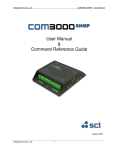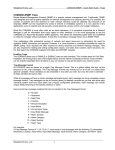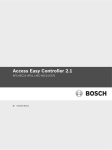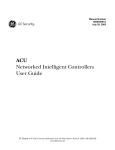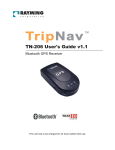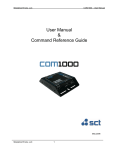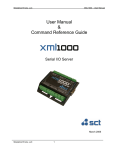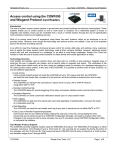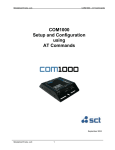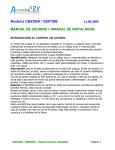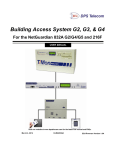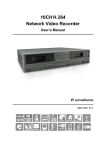Download COM1000 User Manual
Transcript
COM3000-SNMP – Quick Start Guide - Wiegand SimpleComTools, LLC COM3000-SNMP Wiegand Card Access Traps The COM3000-SNMP does come with optional support for a Wiegand card reader interface. This interface takes the place of the RS485 port, providing power and communications for a Wiegand-26 card reader. For these devices, the COM3000 embedded SNMP agent has the ability to forward card data to the network manager in the form of an SNMP trap. In addition, with a locally hosted access list of up to 50 unique card IDs, the COM3000 can also compare the card info it to the local list, and then activate the on-board relay to control an external mechanism such as a door lock. Card readers are typically used on exterior doors and allow entry to a facility or area swiping a magnetic pass or small key fob over a magnetic card reader, and an electric strike or magnetic lock opens. The verification of the card ID takes place either locally at the door (using an intelligent panel) or remotely via a database belonging to a PC based access control system. In the case of the COM3000, it is possible to perform both of these functions, as well as additional applications. Local Access Control Using a locally hosted access (of up to 50 unique card IDs), the COM3000 can read the card reader data, compare it to the local list, and then activate an external door lock or relay. Remote Access The COM3000 can transport the card data to a report server via any LAN or Wireless IP network. Remote Access Control The COM3000 also allows for remote control of the relay via the NMS. So you can choose to not have the Wiegand card swipe trigger the relay and act only as a notification device, and control is done manually. Exception Reporting The COM3000 can send customized trap notifications based upon a successful or unsuccessful match. Easy Local or Remote Configuration/Updates Access lists can be saved as part of a configuration template, and used to program other units. Card Reader Protocol Support The COM3000 currently supports readers using the WIEGAND 26 protocol. The WIEGAND 26 message is a 26-bit message, including a 10-bit Facility ID and a 16-bit Card ID. Supported Readers The following are some examples of readers currently supported in this solution. If you have an interest in another reader, please consult with us at [email protected]. Reader Ordering Info and Base Part Number ProxPoint Plus ProxPoint Plus with Wiegand Output Base Part No: 6005 MiniProx MiniProx with Wiegand Output Base Part No: 5365 ProxPro ProxPro Proximity Reader with Wiegand Output Base Part No: 5355 Classic Swipe Reader SimpleComTools, LLC Classic Swipe Reader with Wiegand Output Base Part No: 310 1 Image COM3000-SNMP – Quick Start Guide - Wiegand SimpleComTools, LLC Connecting the Reader to the COM3000 The card readers connect to one of the two COM3000 Wiegand interfaces Connect the reader using the following wiring table and diagram: Wiring Table Signal Color Description COM3000 Interface Power Red Connected to the COM3000 for a 12VDC power source. TX + Signal Ground Black Tie to shield (shield ground) and connect to COM3000 common ground. COM Shield Ground Shield Tie to black wire (signal ground) and connect to COM3000 common ground. COM Green LED Orange Used to force card reader LED to display green when card ID is positive. TX - Data0 Green One of two required data lines. RX - Data1 White One of two required data lines. RX + Beeper Yellow Unused. Unused. Red LED Brown Unused. Unused. Hold Blue Unused. Unused. Card Present Violet Unused. Unused. Wiring Diagram SimpleComTools, LLC 2 COM3000-SNMP – Quick Start Guide - Wiegand SimpleComTools, LLC Methodology The Wiegand application supports a locally hosted lookup table of (50) card IDs. Each card ID has a number or variables associated with it. They include: - Facility Code - Named Card User (First and Last) - Card Status (Enabled or Disabled) - Access Point - Trap Severity - User phone number - Company or Agency Variables are entered in the following comma delimited format: Card#, Facility Code, First, Last, Card Status (0 or 1), Access Point (0-26), Severity (0-5), Phone, Company Name Examples: USER01:16761,1,John,Doe,1,1,4,555-555-1212,Global Security USER02:14462,1,Fred,Smith,1,1,4,888-888-1212,University Staff Enabling Card Traps Wiegand card reads are sent to the assigned NMS based upon the cards ENABLED or DISBALED status. By default, all card trap messages are disabled regardless of the cards status. To send traps for ENABLED/ACTIVE or DISABLED/INACTIVE cards, you must enable those specific trap message events. You can choose to send traps for ENABLED/ACTIVE cards or for DISABLED/INACTIVE cards – or for all card swipes regardless of status. The choice is yours – but the card status registers must be set in order for traps for those events to be sent. Wiegand Trap Message Format Wiegand traps are still subject to the Trap Message Format. Wiegand messages will have a similar message parameter layout to all other trap messages. The only difference is that the message payload includes far more detail. Here are the trap message variables that can be included in the Wiegand Trap Message: 1 = Hostname 2 = Date/Time 3 = Location 4 = Device Description 5 = Input Name 6 = Current Input Value 7 = Input State Message 8 = Alarm Severity 9 = Alarm Category 10 = Alarm Number 11 = Alarm Type (Wiegand Input Name) (Wiegand Card Data Info) (Wiegand Card User Severity) Example: A Trap Message Format of “1,3,5,7,8,9,11” would result in Wiegand messages with the following parameters: [Hostname, Location, Wiegand Name, Wiegand Message, Alarm Severity, Alarm Category, Alarm Type] | [ Card #, Facility Code, User Name, Status, Access Point, Phone, Company ] As you can see, the “Wiegand Message” is actually the information about the card stored in the COM3000. This includes all the data that is input into the COM100 when the device is configured. (See Methodology). Sample Message: An ENALBED user Wiegand card swipe trap from the John Doe entry shown above would look like this: COM3000, Site 22, Door, 16761, 1, John, Doe, 1, 1, 555-555-1212, Global Security, Informational, SEC, Access Control SimpleComTools, LLC 3 COM3000-SNMP – Quick Start Guide - Wiegand SimpleComTools, LLC Trap Identification There are two ways for an NMS to identify the source of the SNMP trap: 1) Examine the trap OID to obtain the source of the specific alarm 2) Examine the message details within the trap itself Trap Identification Using the Trap OID Each Wiegand card swipe will have an OID that identifies whether or not the card was Enabled or Disabled in the access list. By sending the trap ACK status OID as the source, the COM3000 makes it easy to determine the source of the trap. For example, all DISABLED card traps will have the OID .1.3.6.1.4.1.27404.3.6.1.1.1, and all ENABLED card traps will have the OID .1.3.6.1.4.1.27404.3.6.1.1.1.2. This is the Each of the inputs has a unique sub-group which contains (5) scalar OIDs – the current status of the Disabled and Enabled trap acknowledgements, the last card swipe value, last card swipe time, and the running failure count. OID for all Wiegand information: OID for the Wiegand 1 Group: OID for Wiegand 1 Disabled Trap ACK: OID for Wiegand 1 Enabled Trap ACK: OID for Wiegand 1 Last Card: OID for Wiegand 1 Last Card Time: OID for Wiegand 1 Failure Count: .1.3.6.1.4.1.27404.3.6.1 .1.3.6.1.4.1.27404.3.6.1.1 .1.3.6.1.4.1.27404.3.6.1.1.1.0 .1.3.6.1.4.1.27404.3.6.1.1.2.0 .1.3.6.1.4.1.27404.3.6.1.1.3.0 .1.3.6.1.4.1.27404.3.6.1.1.4.0 .1.3.6.1.4.1.27404.3.6.1.1.5.0 (Group) (Sub-group) (Scalar 1) (Scalar 2) (Scalar 3) (Scalar 4) (Scalar 5) When a DISBALED card trap is sent, it will have the OID for the Wiegand 1 Disabled Trap ACK, (.1.3.6.1.4.1.27404.3.6.1.1.1.0). It is immediately known then that this device has a card swipe from a disabled or enabled user or card. Sending an ACK to the OID will stop the traps from continually being sent. (See section Trap Acknowledgements for more details on formatting the ACK). Trap Identification Using the Trap Message Text Another option for determining the source of the alarm would be to examine the trap message detail. Having a detailed message can provide a great deal more visibility into the source and type of the trap and can help speed the processing of operational decisions. In order to give users the greatest control over the trap message detail, the COM3000 provides the ability to add up to (11) variables to your trap message. Deciding which variables to include in the message is done by setting the Trap Message Format. (Refer to the section entitled Trap Message Format for more info). Wiegand Card Read Trap Acknowledgements Trap acknowledgements are very simple. Each alarm point has unique trap OIDs indicating the status of trap acknowledgements. So when a trap is sent, the OID will actually be the state ACK status OID as the source. Sending an acknowledgement is done simply by sending an SNMP SET command containing any value back this originating OID. This can be something as simple as a 1 or 0 or even the word „ACK‟. The device will see any attempt to write to this point as the NMS acknowledging the trap. This will cease any trap retransmission. For example… Each Wiegand ENABLED and DISBALED trap has their own trap acknowledgement OID. OID for Wiegand 1 Disabled Trap ACK: OID for Wiegand 1 Enabled Trap ACK: .1.3.6.1.4.1.27404.3.6.1.1.1.0 .1.3.6.1.4.1.27404.3.6.1.1.2.0 When a DISBALED card is swiped, the Wiegand card event trap is sent with OID .1.3.6.1.4.1.27404.3.6.1.1.1.0. When an ENABLED card is swiped, the Wiegand card event trap is sent with OID .1.3.6.1.4.1.27404.3.6.1.1.2.0. Simply sending an SNMP SET command with the value 1 to the OID will acknowledge the card read event. SimpleComTools, LLC 4 COM3000-SNMP – Quick Start Guide - Wiegand SimpleComTools, LLC Configuration Parameters There are (12) variables that need to be configured to support Wiegand traps. Parameter Name Wiegand Name Relay Control Disabled/Inactive User Traps Enabled/Active User Traps Disabled/Inactive User Alarm Category Enabled/Active User Alarm Category Disabled/Inactive User Alarm Number Enabled/Active User Alarm Number Disabled/Inactive User Alarm Type Enabled/Active User Alarm Type SimpleComTools, LLC Description Customized Name for the Wiegand interface. A free-text field for naming the Wiegand to your specific requirements. Example: Front Door, Rear Door, etc. Accepts up to 20 characters. Enables or Disables energizing the Relay on a successful card match. Options: 0 = Disabled (DEFAULT) 1 = Enabled Enables or Disables the sending of traps for Disabled/Inactive Users or ID Cards. Options: 0 = Disabled (DEFAULT) (Do NOT send traps for disabled cards) 1 = Enabled (Send traps for Disabled cards) Enables or Disables the sending of traps for Enabled/Active Users or ID Cards. Options: 0 = Disabled (DEFAULT) (Do NOT send traps for disabled cards) 1 = Enabled (Send traps for Enabled cards) A free-text field for entering a category for the type of alarms a Disabled/Inactive User trap represents. Examples: MINOR, STATUS, INFORMATION, SYSTEM, etc. Accepts up to 20 characters. A free-text field for entering a category for the type of alarms Enabled User traps represents. Examples: MINOR, STATUS, INFORMATION, SYSTEM, etc. Accepts up to 20 characters. A numeric field used for assigning a user-defined alarm value to Disabled/Inactive User traps. nnnnn = (5 digit value with range between 1 and 65535). A numeric field used for assigning a user-defined alarm value to Enabled/Active User traps. nnnnn = (5 digit value with range between 1 and 65535). A free-text field for entering a user-defined value for the type of alarm Disabled/Inactive User traps represents. Examples: SYSTEM, SECURITY, FACILITY, etc. Accepts up to 20 characters. A free-text field for entering a user-defined value for the type of alarm Enabled/Active User traps represents. Examples: SYSTEM, SECURITY, FACILITY, etc. Accepts up to 20 characters. 5 COM3000-SNMP – Quick Start Guide - Wiegand SimpleComTools, LLC Allows you to select from one of (12) pre-defined trap types to meet your specific NMS trap reporting requirements. Disabled/Inactive User Trap Type Options: 1000=Inform1 (DEFAULT) 1500=Inform1Restore 2000=Inform2 2500=Inform2Restore 3000=Warn1 3500=Warn1Restore 4000=Warn2 4500=Warn2Restore 5000=Alarm1 5500=Alarm1Restore 6000=Alarm2 6500=Alarm2Restore Note: Entering a number other than what is specified here will result in a trap being sent with a trap number of the number entered. This could result in issues for your NMS if that number is not supported in the COM3000 MIB. Allows you to select from one of (12) pre-defined trap types to meet your specific NMS trap reporting requirements. Enabled/Active User Trap Type SimpleComTools, LLC Options: 1000=Inform1 (DEFAULT) 1500=Inform1Restore 2000=Inform2 2500=Inform2Restore 3000=Warn1 3500=Warn1Restore 4000=Warn2 4500=Warn2Restore 5000=Alarm1 5500=Alarm1Restore 6000=Alarm2 6500=Alarm2Restore Note: Entering a number other than what is specified here will result in a trap being sent with a trap number of the number entered. This could result in issues for your NMS if that number is not supported in the COM3000 MIB. 6 COM3000-SNMP – Quick Start Guide - Wiegand SimpleComTools, LLC Sets the user (Card ID) list. Entries should have the following comma delimited values: Card Number, Facility Code, First Name, Last Name, Card Status (Enabled/Disabled), trap Severity (0-5), Phone, Company Name Entry syntax: Card Number: 5-digit number (nnnnn) Facility Code: 3-digit number (nnn) First Name: Free-text field – supports up to 20 characters Last Name: Free-text field – supports up to 20 characters Card Status: 0 or 1 (See below) Trap Severity: 0-5 (See list below) Phone #: Free-text field – supports up to 20 characters Company: Free-text field – supports up to 20 characters USERS (1-50) Card Status: Allows users/cards to remain in the system but be treated differently. Disabled cards will not be able to activate the relay, but will result in a trap (providing that Disabled User traps are enabled). Options: 0= Disabled (DEFAULT) 1=Enabled Trap Severity: Unlike the other inputs, Wiegand TRAP SEVERITY is inserted into the user configuration. This allows the customer to modify the trap severities or specific users regardless of whether or not the user/card is enabled or disabled Options: 0 = No Severity (DEFAULT) 1 = Minor 2 = Major 3 = Critical 4 = Informational 5 = Restore Entry samples: USER01:16761,1,John,Doe,1,4,555-555-1212,Global Security USER02:14462,1,Fred,Smith ,1,4,888-888-1212,University Staff USER03:13224,1,Allen,Francis ,0,2,877 -777-1212,Unversity Student USER03:13224,1,George,Bush ,1,2,999-999-1212,US Government SimpleComTools, LLC 7







